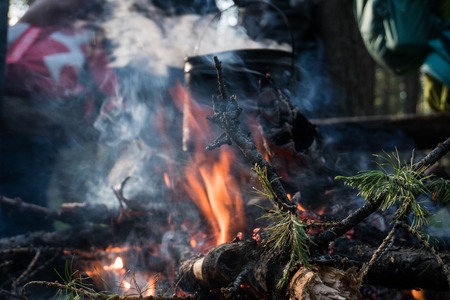Introduction: The Allure of Campfires in the British Countryside
There is a timeless magic in gathering around a glowing campfire beneath the vast, ever-changing skies of the British countryside. For generations, campfires have been woven into the fabric of rural tradition—a place to share stories, toast marshmallows, and find warmth after a brisk day’s ramble through rolling hills or ancient woodlands. The crackle and scent of burning wood evoke both nostalgia and a sense of connection to the wild heart of Britain. Yet, as more people seek solace and adventure outdoors, there is a growing awareness that our cherished rituals must evolve. The beauty of our landscapes—be it heather-clad moors, secluded lakesides, or windswept coastal paths—deserves mindful protection. Embracing campfire traditions now means balancing romance with responsibility: enjoying the glow while ensuring our presence leaves no lasting scar on these treasured places.
Legal Considerations and Local Regulations
When planning a campfire in the UK, it is vital to respect the intricate tapestry of legal frameworks and countryside codes that protect the nation’s diverse landscapes. The United Kingdom upholds strict rules regarding open fires, especially across national parks, nature reserves, and public lands. Adhering to these regulations not only preserves natural beauty but also demonstrates respect for local communities and fellow outdoor enthusiasts.
The Importance of Compliance
Fires can easily get out of hand, causing significant damage to fragile ecosystems, wildlife habitats, and even endangering human life. Because of this, many councils and park authorities have clear-cut policies on where and when campfires are permitted. Ignoring such guidelines can result in hefty fines or prosecution—a sobering reminder that personal responsibility goes hand in hand with the privilege of enjoying the outdoors.
Key Regulations at a Glance
| Location | Fire Policy | Additional Notes |
|---|---|---|
| National Parks (e.g., Lake District, Peak District) | Open fires usually prohibited; designated areas only | Check with local rangers or visitor centres for specific rules |
| Countryside & Public Lands | Strictly regulated; often not allowed without landowner’s permission | Countryside Code applies; always leave no trace |
| Private Land | Landowner’s consent required | Obtain written permission whenever possible |
| Forestry Commission Sites | No open fires; use approved barbecue facilities if available | Follow all posted signs and guidance from staff |
The Countryside Code: A Gentle Reminder
The Countryside Code acts as a gentle yet firm guide for anyone venturing into rural Britain. It asks visitors to respect others, protect the natural environment, and enjoy the outdoors responsibly. This means sticking to marked paths, refraining from lighting fires where they are not allowed, and taking all rubbish away. Observing these principles ensures that the wild heart of the UK remains unspoiled for generations to come.
![]()
3. Choosing a Safe Location for Your Campfire
There’s a certain magic in gathering around a campfire, especially under the wide, ever-changing British sky. Yet, the beauty of our wild spaces comes with a responsibility to preserve them for future generations. When selecting the perfect spot for your campfire, it’s crucial to think beyond warmth and storytelling—consideration for the landscape, wildlife, and fellow campers must be at the heart of your decision.
Minimise Impact on the Landscape
Seek out established fire rings or designated fire pits wherever possible—these areas are designed to contain flames and prevent unnecessary scarring of the earth. If these aren’t available, choose bare soil or gravel rather than lush grass or moss. Avoid peatlands entirely, as they are highly flammable and ecologically sensitive. Always ensure you’re well away from overhanging branches, dry bracken, or leaf litter that could easily catch alight.
Respect Wildlife and Habitats
The UK’s countryside is alive with subtle movement—hedgehogs rustling in the undergrowth, owls swooping silently overhead. To safeguard these creatures, avoid building fires near animal burrows, nesting sites, or waterways. The banks of rivers and lakes are particularly delicate; flames and heat can harm aquatic habitats and disturb wildlife routines. Instead, set up your fire at least 50 metres from water sources and nature-rich zones.
Consider Fellow Campers
Britain’s wild places are shared by many who seek their own moments of tranquillity. Place your campfire at a respectful distance from footpaths, campsites, and communal areas to minimise smoke drift and noise disruption. Always be mindful of prevailing winds which can carry embers—and scents—farther than you might expect.
By carefully choosing where you build your campfire, you’ll not only protect the UK’s treasured landscapes but also create a safer, more harmonious experience for yourself and everyone who wanders beneath these ancient trees and open skies.
4. Building and Maintaining a Safe Fire
Gathering around a campfire is a cherished British pastime, whether on a blustery Dartmoor evening or beside the gentle banks of the Lake District. However, enjoying this tradition means embracing responsible fire-building methods that preserve the beauty and safety of our wild places. Start by choosing an appropriate location: always use designated fire pits where available, or clear a circle free from vegetation and overhanging branches if permitted.
Choosing Traditional British Firewood
The soul of any campfire lies in its wood. In the UK, native hardwoods such as oak, ash, and beech are favoured for their slow-burning qualities and steady heat. Avoid using softwoods like pine, which can spit dangerously and produce excessive smoke. Never collect living wood or strip bark from trees; instead, bring pre-seasoned logs or source sustainably harvested local firewood.
| Type of Wood | Burn Quality | Sustainability |
|---|---|---|
| Oak | Long-lasting, steady heat, minimal smoke | Excellent (if locally sourced) |
| Ash | Easy to split, burns well even when slightly damp | Good (ensure not from diseased sources) |
| Beech | Bright flame, good heat output | Good (from managed woodlands) |
| Pine/Spruce | Quick to light but spits and smokes | Poor (use only if seasoned well and no alternatives) |
Step-by-Step Fire-Building Guide
- Clear the Area: Remove leaves and debris within at least a 1-metre radius.
- Laying the Base: Place a platform of dry sticks or stones to insulate your fire from damp ground.
- Tinder: Use natural materials such as dry grass, birch bark, or cotton wool—never accelerants.
- Kindling: Stack small twigs in a teepee or crisscross style above the tinder.
- Main Fuel: Gradually add larger logs once kindling is alight, ensuring airflow between pieces.
- Supervise: Never leave your fire unattended; keep water and a spade nearby for emergencies.
Best Practices for Fire Safety
- Wind Awareness: Position your fire downwind from tents and gear.
- Spark Protection: Use stones to border the fire and prevent embers escaping.
- Dousing Properly: When finished, thoroughly soak all embers with water and stir until cold to the touch—never simply bury hot ashes.
- No Trace Left Behind: Scatter cooled ashes away from camp and restore the site to its natural state.
The Heartbeat of a Responsible Campfire
A campfire should warm more than just your hands—it should kindle respect for our shared landscapes. By following these time-honoured British practices, you create not only safety but also a deeper connection with nature’s quiet rhythms. Let your fire burn bright in memory, not in mishap.
5. Sustainable Alternatives to Traditional Campfires
While the allure of a crackling campfire is deeply woven into our countryside escapes, the UK’s diverse landscapes and ever-changing weather demand a thoughtful approach to outdoor cooking and warmth. Fortunately, there are low-impact alternatives that honour both tradition and the environment, especially when seasonal restrictions due to wildfire risks come into play.
Portable Stoves: Practical and Precise
Portable stoves have become an essential companion for modern campers across Britain. Compact and efficient, these stoves allow you to brew tea or whip up a hearty meal without leaving any trace. From gas canisters to biofuel options, they’re designed for minimal environmental impact—no scorching the earth or scattering ash. Their reliability means you can enjoy a hot cuppa even in the drizzle of a Lake District morning or on the breezy cliffs of Cornwall.
Fire Bowls: Contained Warmth
If it’s ambience you seek, fire bowls offer a charming compromise. Raised from the ground, these contained vessels protect grass and soil while providing gentle warmth and light. Many models are lightweight and easy to transport, making them perfect for glamping sites or family gatherings in permitted areas. Always check local guidelines, as some places may restrict open flames during dry spells.
Candle Lanterns: Subtle Glow
For those evenings when fire bans are in effect or you simply want to tread lightly, candle lanterns evoke a soft, nostalgic glow reminiscent of village fêtes and garden parties. They add atmosphere without heat or smoke, making them ideal for summer bivouacs or picnic suppers after sunset. Opt for reusable lanterns and soy-based candles for an even gentler touch on the landscape.
Respecting Seasonal Restrictions
The British countryside is particularly vulnerable during hot, dry spells—especially on heathland and moorland where wildfires can devastate habitats. Always consult local authorities before lighting any flame, regardless of method. Embracing sustainable alternatives ensures your outdoor adventure remains harmonious with the land, preserving its beauty for future wanderers.
6. Leave No Trace: Cleaning Up with Care
There is a quiet magic in the wild corners of the UK, from the mossy woodlands of the Lake District to the windswept heaths of Dartmoor. These landscapes have stood for centuries, shaped by weather and time—places where every visitor leaves a mark, whether seen or unseen. As guardians of these cherished spaces, it is our shared responsibility to ensure that our presence does not diminish their beauty.
Ethical Campfire Extinguishing
At the heart of responsible wild camping lies the art of extinguishing a campfire with absolute care. Allow your fire to burn down to ash, then pour water slowly over the embers, stirring gently until all hissing ceases and the site is cool to the touch. Avoid scattering hot coals, as this can scar delicate ground flora and pose a hidden hazard for wildlife. In especially sensitive areas, it’s best to avoid fires altogether and opt for portable stoves or flameless cooking solutions.
Restoring the Landscape
After ensuring your fire is out cold, return any displaced stones or turf to their original positions. If you’ve used a fire bowl or raised grill, scatter any cooled ash widely so it blends harmlessly with soil. Remove all traces of kindling or burnt wood—pack them out if possible—and check for stray bits of rubbish or food scraps. Even biodegradable litter can disrupt local ecosystems or attract unwelcome animals.
Cherishing Wild Beauty
The wild places of Britain are woven with stories—of ancient paths, rare flowers, and quiet mornings shrouded in mist. When we leave no trace, we honour these stories and preserve them for those who follow. Before you depart, pause and look back: your campsite should appear untouched, as if your night beneath the stars was but a fleeting dream upon the land.
By tending to our surroundings with intention and respect, we keep alive the wonder that draws us into nature’s embrace. The privilege of camping in the UK’s great outdoors comes with a simple promise—to take nothing but memories, leave nothing but footprints, and let every place remain as beautiful as we found it.
7. Embracing the Spirit of Outdoor Gatherings Beyond the Fire
The British countryside has always been a tapestry woven with stories, laughter, and shared moments. While the glow of a campfire often conjures images of warmth and camaraderie, true outdoor connection in the UK is about more than flickering flames. Even without a fire’s embrace, we find ourselves drawn together by the gentle hush of dusk settling over the fells, the scent of wildflowers on a coastal breeze, or the crisp crunch of autumn leaves beneath our boots.
Celebrating Togetherness in Every Season
There is an unmistakable magic to gathering outdoors—be it under star-pricked skies or beneath the sheltering arms of ancient oaks. British traditions, from picnics on village greens to rambles across moorland, remind us that community flourishes wherever people meet in nature. Whether sharing tales of local folklore, passing around mugs of tea from a battered flask, or simply enjoying companionable silence as clouds drift overhead, these moments become woven into our collective memory.
The Joys of Simple Pleasures
Embracing sustainable practices doesn’t mean sacrificing joy. Swapping fires for lanterns or blankets opens new ways to savour British outdoor life: perhaps a night walk guided by torches and owl calls; a beach gathering with thermos-warmed cocoa; or an afternoon spent sketching wild landscapes while friends read poetry aloud. These alternatives nurture both land and spirit, ensuring future generations can cherish these spaces too.
A Lasting Invitation
So whether you’re huddled round a carefully managed campfire or seeking warmth in shared stories and laughter, let the heart of British outdoor tradition guide you. Relish the camaraderie, treasure the small delights—raindrops on canvas, tart berries foraged from hedgerows, or the simple comfort of good company beneath ever-changing skies. In doing so, you’ll not only protect cherished wild places but also keep alive the timeless spirit of gathering that makes our countryside truly special.


